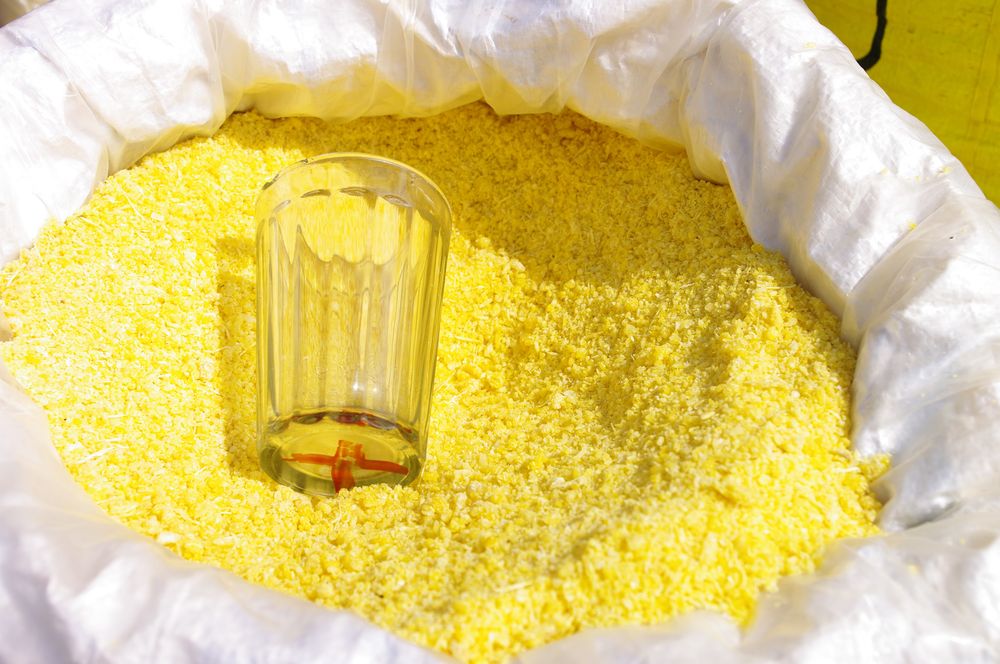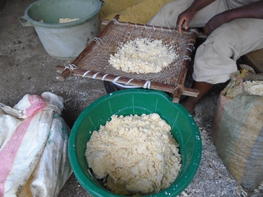Partner Institute Contacts
ENSAI (Cameroon): Robert NDJOUENKEU
IITA (Nigeria & Cameroon): Busie MAZIYA-DIXON
More About Gari?
Ndjouenkeu, R., Ngoualem Kegah, F., Teeken, B. & al. (2021), From cassava to gari: mapping of quality characteristics and end‐user preferences in Cameroon and Nigeria. Int J Food Sci Technol, 56(3). https://doi.org/10.1111/ijfs.14790
Akely, P.M.T., Gnagne, E.H., To Lou, G.M.‐L.T. and Amani, G.N. (2021), Varietal influence of cassava on chemical composition and consumer acceptability of gari. Int J Food Sci Technol (56)3 https://doi.org/10.1111/ijfs.14610
Dahdouh, L., Escobar, A., Rondet & al. (2021), Role of dewatering and roasting parameters in the quality of handmade gari. Int J Food Sci Technol, 56(3). https://doi.org/10.1111/ijfs.14745
Escobar, A., Rondet, E., Dahdouh & al. (2021), Identification of critical versus robust processing unit operations determining the physical and biochemical properties of cassava‐based semolina (gari). Int J Food Sci Technol, 56(3). https://doi.org/10.1111/ijfs.14857
Thiele, G., Dufour, D., Vernier, P. & al. (2021), A review of varietal change in roots, tubers and bananas: consumer preferences and other drivers of adoption and implications for breeding. Int J Food Sci Technol, 56(3). https://doi.org/10.1111/ijfs.14684
Scott, G.J. (2020), A review of root, tuber and banana crops in developing countries: past, present and future. Int J Food Sci Technol, 56(3). https://doi.org/10.1111/ijfs.14778
Adebayo, B. A., Nanam, T. D., Bamidele, E. A., & Braima, D. J. (2012). Quality management manual for the production of Gari. International Institute of Tropical Agriculture.
Adinsi, L., Akissoé, N., Escobar, A., Prin, L., Kougblenou, N., Dufour, D., Hounhouigan, D. J., & Fliedel, G. (2019). Sensory and physicochemical profiling of traditional and enriched gari in Benin. Food Science & Nutrition, 7(10), 3338–3348. https://doi.org/10.1002/fsn3.1201
Ikpe, N. E., & Essienubong, I. A. (2016). Optimization of indigenous food (Gari) fermentation with respect to time and texture. International Journal of Innovative Science, Engineering & Technology, 3(7), 98–107.
Levai, L. D., Nsimi, M. A., Nana, G., Ngone, A. M., Amayana, A., Sama, A. M. L., & Ngome, F. A. (2016). Consumer perception of Gari prototypes and prospects for improvement and marketing in the South West region of Cameroon. International Journal of Agriculture and Environmental Research, 2(5), 1304–1318.
Mapiemfu-Lamaré, D., Ngome, F. A., Eyenga, E. F., Mbassi, J. E. G., & Suh, C. (2017). Harvesting date influences Cassava (Manihot Esculenta Crantz) yield and quality of based-products. Current Research in Agricultural Sciences, 4(3), 75–83. https://doi.org/10.18488/journal.68.2017.43.75.83
Udofia, P. G., Udoudo, P. J., Eyen, P. J., & Udoekong, N. S. (2011). Optimizing gari quality attributes for different groups of consumers with response surface methodology. Journal of Agricultural Biotechnology and Sustainable Development, 3(2), 28–34.



